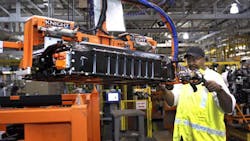Jobs: Overall Economy, A; Manufacturing, B-minus
For the economy as a whole, the monthly jobs report issued this morning by the Labor Department's Bureau of Labor Statistics paints a rosy picture. But for the manufacturing sector, the verdict, while mildly positive overall, is mixed.
Overall, U.S. employers added a net 288,000 jobs in June, significantly more than the 215,000 economists had projected. And the unemployment rate dropped from 6.3% to 6.1%, its lowest mark since September 2008.
The manufacturing sector, on the other hand, added a net 16,000 workers in June. This is the 11th consecutive monthly net job gain for U.S. manufacturers—good news for sure—but that monthly growth figure is minuscule compared to the economy as a whole.
In addition, as the table below shows, the job gains in manufacturing are uneven. Durable Goods (+17,000 jobs) did far better than Nondurables (-1,000). Within Durables, the subsectors with the best showings were Transportation Equipment (+8,900), Motor Vehicles & Parts (+5,900), and Machinery (+3,800). Within Nondurables, the biggest loss by far was in Food Manufacturing, which shed 4,800 jobs; on the plus side, Chemical Manufacturing added 1,900.
| MANUFACTURING EMPLOYMENT BY SECTOR (Thousands of Jobs) | |||
| May '14 | June '14 | Change | |
| Manufacturing - Total | 12,105.0 | 12,121.0 | 16.0 |
| Durable Goods- Total | 7,640.0 | 7,657.0 | 17.0 |
| Wood Products | 366.9 | 367.1 | 0.2 |
| Nonmetallic Mineral Products | 384.5 | 384.8 | 0.3 |
| Primary Metals | 398.0 | 399.9 | 1.9 |
| Fabricated Metal Products | 1,452.8 | 1,452.8 | 0.0 |
| Machinery | 1,124.7 | 1,128.5 | 3.8 |
| Computer & Electronic Products | 1,056.0 | 1,057.7 | 1.7 |
| ►Computer & Peripheral Equipment | 164.2 | 166.8 | 2.6 |
| ►Communications Equipment | 98.1 | 98.3 | 0.2 |
| ►Semiconductors & Electronic Components | 368.7 | 368.6 | -0.1 |
| ►Electronic Instruments | 386.4 | 385.2 | -1.2 |
| Electrical Equipment & Appliances | 374.9 | 375.4 | 0.5 |
| Transportation Equipment | 1,536.6 | 1,545.5 | 8.9 |
| ►Motor Vehicles & Parts | 850.7 | 856.6 | 5.9 |
| Furniture & Related Products | 365.4 | 365.6 | 0.2 |
| Miscellaneous Durable Goods | 580.4 | 579.4 | -1.0 |
| Nondurable Goods - Total | 4,465.0 | 4,464.0 | -1.0 |
| Food | 1,476.5 | 1,471.7 | -4.8 |
| Textile Mills | 116.8 | 116.9 | 0.1 |
| Textile Product Mills | 110.5 | 110.1 | -0.4 |
| Apparel | 132.0 | 132.0 | 0.0 |
| Paper & Paper Products | 376.8 | 376.7 | -0.1 |
| Printing & Related Support Activities | 441.5 | 441.6 | 0.1 |
| Petroleum & Coal Products | 113.1 | 114.0 | 0.9 |
| Chemicals | 800.3 | 802.2 | 1.9 |
| Plastics & Rubber Products | 663.0 | 663.5 | 0.5 |
| Miscellaneous Nondurable Goods | 234.4 | 235.5 | 1.1 |
| Source: U.S. Bureau of Labor Statistics | |||
Tepid Evaluations
Manufacturing analysts' assessments of the monthly jobs report were lukewarm.
Alan Tonelson, research fellow with the U.S. Business and Industry Council, noted that while the monthly and year-on-year job gains for June are good news, the manufacturing sector still acutely lags the overall economy in creating new jobs.
"Manufacturing's lagging recent hiring progress shows that industry’s jobs rebound earlier during the economic recovery was purely cyclical, not structural, and that contrary to President Obama and others, no structural domestic manufacturing renaissance is in sight," Tonelson said.
Chad Moutray, chief economist with the National Association of Manufacturers, said that while the jobs report provides "mostly positive news," he is troubled by the fact that most of the growth came from Durable Goods subsectors, which are heavily dependent on exports. For that reason, he said, manufacturers need to push Congress to reauthorize the Export-Import Bank, which promotes the export of U.S.-manufactured goods.
"According to estimates, the Ex-Im Bank supports 6,390 jobs per $1 billion of U.S. exports," Moutray wrote in NAM's Shopfloor blog. "From 2009 to 2013, the Ex-Im Bank provided $188 billion of U.S. export assistance, which calculates to 1.2 million U.S. jobs supported. Re-authorization of the Ex-Im Bank is an area where policymakers can have a direct positive impact on greater hiring and economic activity right now."
Scott Paul, president of the Alliance for American Manufacturing, noted that the report shows that manufacturing accounted for only 5.6% of job growth in June, "far below its weight in the wider economy."
"Our growing trade deficit with China, currency manipulation by overseas competitors, and a paucity of investment in infrastructure are leaving factory jobs at a virtual standstill," Paul said. "With the right policies from this administration and Congress, it’s entirely possible to grow manufacturing employment. But until then, the idea of a resurgence in the sector simply isn't supported by the data."
"As an industry, manufacturing has added back only one-fourth of the jobs it lost during the Great Recession," Paul added. "Five years into a recovery, that’s not good enough."
About the Author
Pete Fehrenbach
Pete Fehrenbach, Associate Editor
Focus: Workforce | Chemical & Energy Industries | IW Manufacturing Hall of Fame
Follow Pete on Twitter: @PFehrenbachIW
Associate editor Pete Fehrenbach covers strategies and best practices in manufacturing workforce, delivering information about compensation strategies, education and training, employee engagement and retention, and teamwork. He writes a blog about workforce issue called Team Play.
Pete also provides news and analysis about successful companies in the chemical and energy industries, including oil and gas, renewable and alternative.
In addition, Pete coordinates the IndustryWeek Manufacturing Hall of Fame, IW’s annual tribute to the most influential executives and thought leaders in U.S. manufacturing history.

